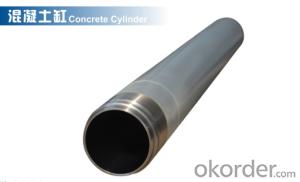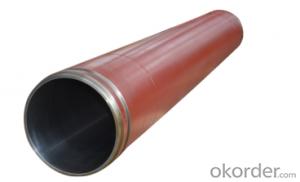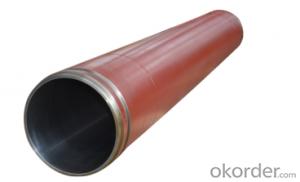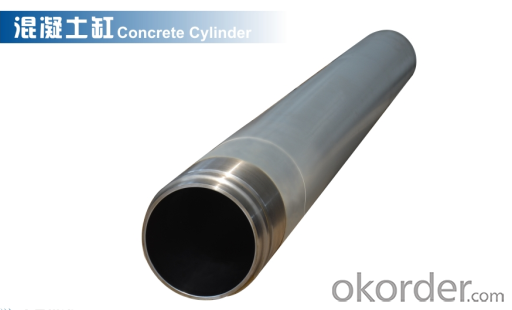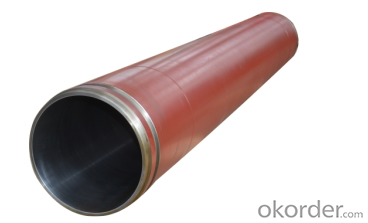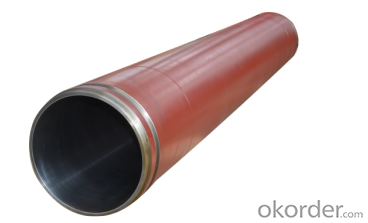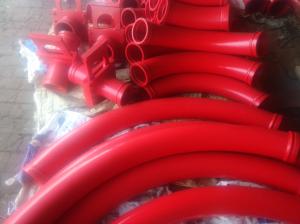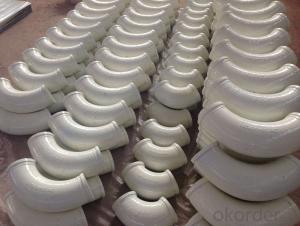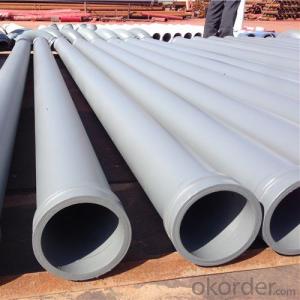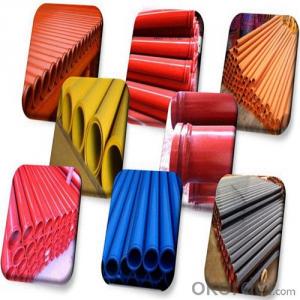DELIVERY CYLINDER(SCHWING ) I.D.:DN200 CR. THICKNESS :0.25MM-0.3MM COLOR:WHITE LENGTH:2125MM
- Loading Port:
- Shanghai
- Payment Terms:
- TT OR LC
- Min Order Qty:
- 2 pc
- Supply Capability:
- 1000 pc/month
OKorder Service Pledge
Quality Product, Order Online Tracking, Timely Delivery
OKorder Financial Service
Credit Rating, Credit Services, Credit Purchasing
You Might Also Like
Packaging & Delivery
| Packaging Detail: | wooden case, seaworthy packing |
| Delivery Detail: | 15 days |
Specifications
Concrete Pump Delivery Cylinder DN230*2100
1. Capacity: 60,000~80,000cbm
2. Size: DN180, DN200, DN230..
4. Brand: PM, Sany,ZM
Concrete Pump Delivery Cylinder DN230*2100
1. Material: C45
2. quenching and tempering to improve the hardness to HB241-280
3. inner wall chrome thickness is 0.25-0.30mm, hardness HV820-900.
4. Brand: SCHWING, PM, SANY, KYOKUTO, CIFA
5. Capacity: 60,000~80,000cbm
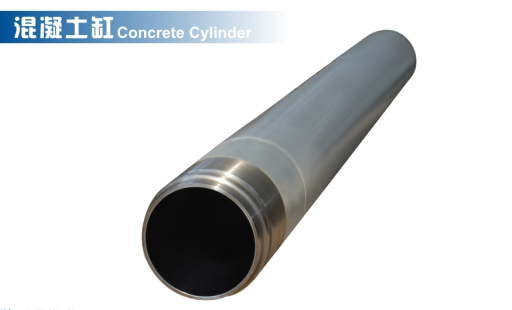
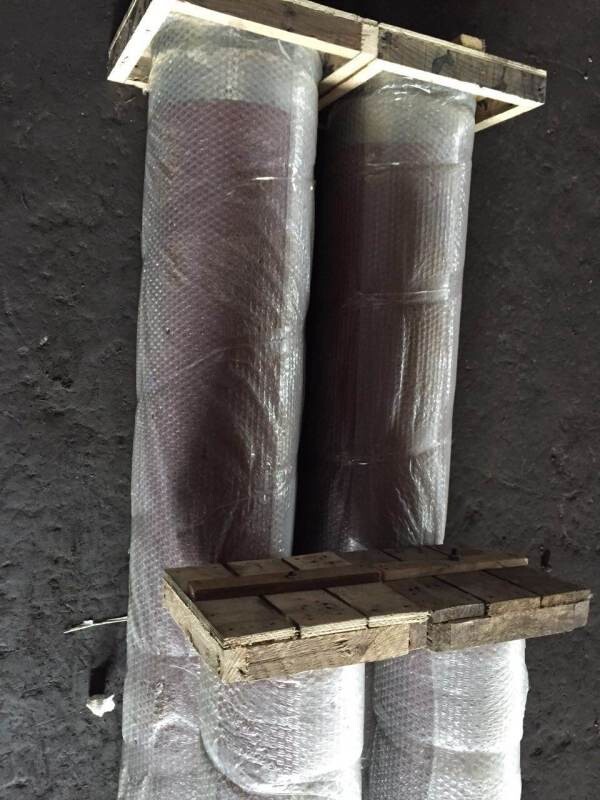
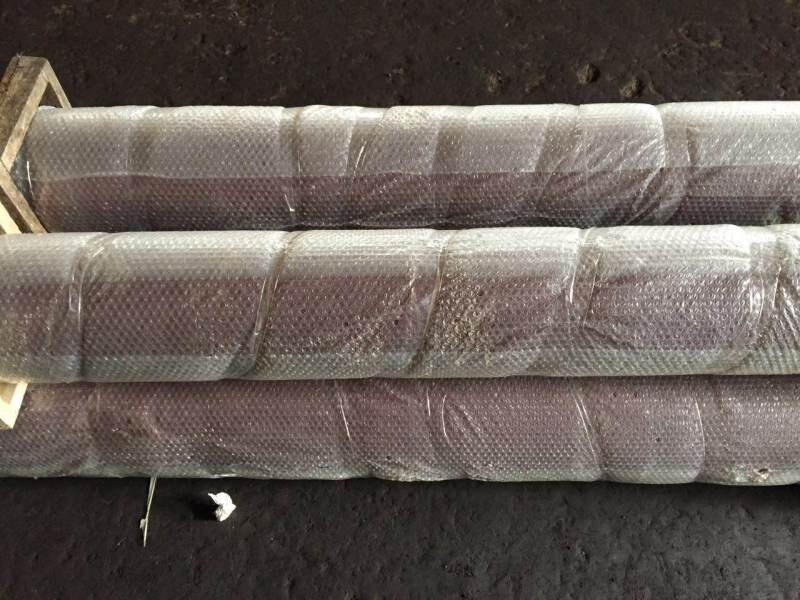
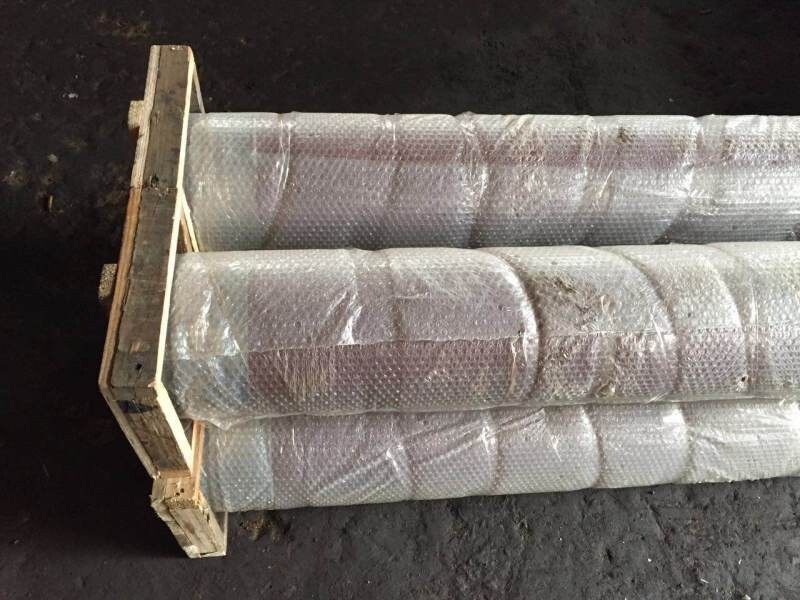
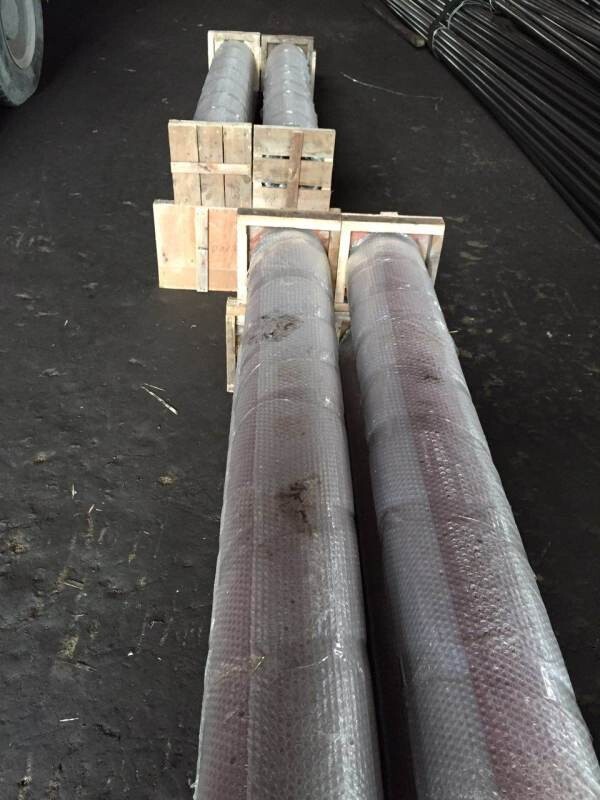
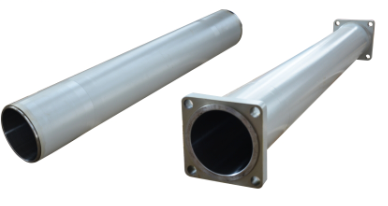
- Q: How can one ensure compatibility between concrete pump spare parts and the pump?
- To maintain the efficiency and performance of the equipment, it is crucial to ensure compatibility between concrete pump spare parts and the pump. Here are several steps to guarantee compatibility: 1. Start by identifying the correct model and manufacturer. Gather all necessary information about the concrete pump, such as the model number and manufacturer. This information will assist in finding spare parts specifically designed for that particular pump model. 2. Always opt for genuine spare parts. It is highly recommended to use authentic spare parts provided by the pump manufacturer or authorized distributors. Genuine parts are designed and tested to meet the pump's specifications, ensuring a perfect fit and compatibility. 3. Verify part numbers and specifications before making any purchases. Carefully compare the part numbers and specifications with the original parts to ensure compatibility with the pump. 4. Seek guidance from experts or the manufacturer's technical support team if unsure about the compatibility of certain spare parts. Their expertise and experience can provide valuable guidance and advice. 5. Regularly inspect and maintain the concrete pump to identify any wear or damage to the parts. This will enable the identification of specific spare parts that require replacement and ensure compatibility with the pump. 6. Prioritize quality and reliability when selecting spare parts, even if cost is a factor. Investing in high-quality parts guarantees better performance, durability, and compatibility with the pump. By following these steps, one can maximize the lifespan, performance, and overall efficiency of the concrete pump by ensuring compatibility between the spare parts and the pump.
- Q: How do I properly maintain and replace hydraulic hoses in concrete pump spare parts?
- To ensure the smooth functioning and longevity of your equipment, it is crucial to properly maintain and replace hydraulic hoses in concrete pump spare parts. Here are some effective steps you can take: 1. Conduct regular visual inspections to identify any signs of wear, damage, or leaks. Look for bulges, cracks, abrasions, or fraying. Pay attention to fittings, connections, and bends in the hose. 2. Implement a preventive maintenance schedule to reduce the chances of unexpected hose failure. Clean the hoses regularly to remove dirt, debris, and concrete residues that may cause abrasion or clogging. Use a mild detergent and water, and ensure thorough drying. 3. Store hydraulic hoses in a clean, dry, and temperature-controlled environment when not in use. Protect them from direct sunlight, extreme temperatures, and chemicals to avoid degradation. 4. Handle hydraulic hoses with care to prevent damage. Avoid dragging them on rough surfaces or sharp edges that can cause cuts or abrasions. Minimize excessive kinking or twisting, as it weakens the internal structure. 5. Replace hydraulic hoses promptly upon noticing signs of wear, damage, or leaks. Do not wait for hose failure, as it can lead to costly downtime and safety hazards. Follow the manufacturer's recommendations for replacement intervals. 6. Use high-quality replacement hoses that are compatible with your concrete pump. Choose hoses that meet industry standards and specifications for durability in concrete pumping conditions. 7. Properly install replacement hoses, ensuring correct routing and secure connections to fittings. Use appropriate tools and techniques to tighten fittings, avoiding over-tightening that can damage the hose or fittings. 8. Provide regular training to your staff on proper maintenance, inspection, and replacement procedures for hydraulic hoses. This will enhance their knowledge and skills, reducing the risks of improper handling or installation. By following these steps, you can effectively maintain and replace hydraulic hoses in concrete pump spare parts, ensuring the safety and efficiency of your equipment. Always refer to the manufacturer's guidelines and seek professional assistance when needed.
- Q: How does a hydraulic accumulator improve the performance of a concrete pump?
- To ensure a constant and reliable flow of concrete, a hydraulic accumulator is employed to enhance the performance of a concrete pump. The primary role of this hydraulic device is to store hydraulic energy in the form of pressurized fluid. In the case of a concrete pump, it stores and releases energy from the hydraulic system as needed during the pumping process. Efficiency and productivity in concrete pumping rely on a consistent flow of concrete. However, variations in demand or pressure fluctuations can pose challenges. This is where the hydraulic accumulator comes into play. By storing surplus hydraulic energy, the accumulator acts as a buffer, smoothing out any irregularities in the hydraulic system. When additional power is required, the stored energy is released, providing a boost to the hydraulic system. This ensures a continuous and steady flow of concrete, even during periods of high demand or pressure changes. Furthermore, hydraulic accumulators also contribute to reducing wear and tear on the pump components. By absorbing and dampening pressure shocks, they prevent sudden spikes and fluctuations from reaching the pump. This helps to extend the pump's lifespan and minimize the risk of breakdowns or damage. Overall, a hydraulic accumulator plays a critical role in enhancing the performance of a concrete pump. It ensures a steady flow of concrete, reduces pressure fluctuations, and protects the pump from excessive wear and tear. This results in improved efficiency, reliability, and durability of the pump, ultimately leading to increased productivity and cost savings in concrete pumping operations.
- Q: Are there any specific tools required for replacing concrete pump spare parts?
- There exist certain tools that are essential for the replacement of concrete pump spare parts. Among the frequently used tools are wrenches, socket sets, screwdrivers, pliers, hammers, and pry bars. Furthermore, specific tools like concrete pump piston pullers, gasket cutters, and sealant applicators may be required depending on the particular parts being replaced. To guarantee a secure and effective replacement of concrete pump spare parts, it is crucial to possess the appropriate tools.
- Q: What are the different types of concrete pump hopper cylinders seals?
- Concrete pump hopper cylinder seals come in various types, each catering to specific needs and requirements. The most commonly used types are as follows: 1. Piston seals: These seals prevent leakage between the piston and cylinder bore. They are typically crafted from durable materials like rubber or polyurethane, ensuring resistance to wear and tear. 2. Rod seals: Installed on the piston rod, rod seals prevent leakage between the rod and cylinder head. They are commonly made of rubber or fabric-reinforced rubber, delivering reliable sealing even in high-pressure conditions. 3. Wiper seals: These seals are utilized to remove dirt, dust, and other contaminants from the retracting piston rod. They are usually composed of polyurethane or rubber, effectively sealing and protecting the cylinder. 4. Wear rings: Employed to decrease friction and prevent metal-to-metal contact between the piston and cylinder bore, wear rings are usually made of materials like bronze or Teflon. They significantly extend the cylinder's lifespan by reducing wear and tear. 5. Backup rings: These rings provide additional support and stability when used alongside other seals. Typically crafted from materials like rubber or PTFE, backup rings prevent extrusion and damage to the primary seal. In summary, the choice of the appropriate concrete pump hopper cylinder seal relies on factors such as the specific application, operating conditions, and desired performance characteristics. It is crucial to select seals that are compatible with the material being pumped, offer effective sealing, and have a long lifespan to ensure optimal performance and minimize maintenance needs.
- Q: How can one extend the lifespan of concrete pump spare parts?
- There are several measures that can be taken to extend the lifespan of concrete pump spare parts: 1. Maintenance should be performed regularly. This includes cleaning, lubricating, and inspecting the parts for signs of wear or damage. By addressing any issues early on, further damage can be prevented and the lifespan of the parts can be prolonged. 2. Proper storage is important. When not in use, the spare parts should be stored in a clean and dry environment. Exposure to moisture, dust, and other contaminants can cause corrosion and deterioration of the parts. Storing them in a designated area with appropriate protection can help prevent these issues. 3. Investing in high-quality spare parts can greatly impact their lifespan. Choosing reputable brands and manufacturers that produce durable and reliable parts can ensure their longevity. Despite the initial higher cost, they will save money in the long run as they will require less frequent replacement. 4. Following the manufacturer's guidelines and instructions for the concrete pump spare parts is crucial. Overloading or operating the equipment improperly can put excessive strain on the parts, resulting in premature wear and tear. Using the parts within their recommended capacity and following proper operating procedures will help extend their lifespan. 5. Proper training and supervision of operators and maintenance personnel is essential. Educating them on best practices, proper handling, and maintenance techniques will prevent misuse or mishandling that can damage the parts. 6. Regular inspections should be conducted to identify potential issues early on. This includes checking for signs of wear, damage, or misalignment. By addressing these issues promptly, further damage can be prevented and the lifespan of the parts can be extended. By implementing these measures, the lifespan of concrete pump spare parts can be significantly extended, resulting in reduced downtime and improved efficiency in construction projects.
- Q: How often should the concrete pump wear plate be replaced?
- The frequency of replacing the concrete pump wear plate depends on several factors such as the type of concrete being pumped, the volume of concrete being pumped, and the operating conditions of the pump. Generally, wear plates are designed to withstand a certain amount of wear and tear before requiring replacement. In most cases, it is recommended to inspect the wear plate regularly to check for signs of excessive wear. This can include visible cracks, erosion, or a significant decrease in thickness. Regular visual inspections can help determine when it is time to replace the wear plate. Additionally, monitoring the pump's performance and efficiency can also provide insights into the wear and tear on the wear plate. If there is noticeable decrease in the pump's output or an increase in the required pumping pressure, it may indicate that the wear plate needs to be replaced. However, it is important to consult the manufacturer's guidelines and recommendations for your specific concrete pump model. They often provide recommendations on the expected lifespan of the wear plate and the intervals at which it should be replaced. Following these guidelines can help ensure optimal performance and longevity of your concrete pump.
- Q: How do I troubleshoot issues related to concrete pump spare parts control systems?
- To troubleshoot issues related to concrete pump spare parts control systems, it is important to follow a systematic approach. Here are some steps you can take: 1. Identify the problem: Begin by clearly identifying the issue you are experiencing with the control system. Is it not working at all? Are there specific functions or components that are not functioning correctly? Understanding the problem will help guide your troubleshooting efforts. 2. Check power supply: Ensure that the control system is receiving proper power supply. Check the power source, circuit breakers, and fuses to ensure there are no interruptions or faults in the electrical supply. If needed, replace or repair any faulty components. 3. Inspect connections: Examine the wiring connections and terminals within the control system. Loose or damaged connections can cause issues with the functioning of the system. Tighten any loose connections and repair or replace any damaged wiring. 4. Review control settings: Verify that the control settings are correctly adjusted according to the manufacturer's specifications. Incorrect settings can lead to malfunctions or inefficient operation. Consult the user manual or contact the manufacturer for guidance on proper control settings. 5. Perform diagnostic tests: Many control systems have built-in diagnostic features or error codes that can help identify specific issues. Consult the system's manual to understand how to access and interpret these diagnostic tools. Run any recommended diagnostic tests to pinpoint the problem area. 6. Inspect sensors and actuators: Sensors and actuators play a crucial role in the control system's operation. Check these components for any damage, misalignment, or malfunctioning. Clean or replace sensors as needed and ensure the actuators are properly connected and functioning correctly. 7. Consult technical support: If you have followed the above steps and are still unable to resolve the issue, it may be helpful to contact the manufacturer's technical support team. They can provide expert guidance on troubleshooting the specific control system and may suggest additional steps or solutions. Remember to always prioritize safety when troubleshooting control systems. Ensure that the pump is turned off and disconnected from the power source before working on any electrical components. If you are unsure or uncomfortable with any troubleshooting steps, it is best to seek professional assistance.
- Q: How often should concrete pump water pumps be inspected and replaced?
- The inspection and replacement frequency for concrete pump water pumps relies on multiple factors, including workload, operating conditions, and maintenance practices. It is generally advisable to inspect the water pump once a month to ensure proper functioning. During the inspection, it is crucial to check for leaks, unusual noises, and signs of wear and tear. If any issues are detected, immediate action should be taken, such as repairing or replacing damaged parts. Regarding replacement, it is challenging to provide an exact timeframe as it varies based on the pump's quality, intensity of use, and maintenance level. However, a general recommendation is to consider replacing the water pump every 1-2 years for heavy usage or every 3-5 years for moderate usage. Regular maintenance, including cleaning and lubricating the pump, can extend its lifespan and reduce the need for frequent replacements. It's important to note that these suggestions are general guidelines and may differ based on the manufacturer's instructions, industry standards, and local regulations. It is advisable to consult the manufacturer's guidelines and seek professional advice from experts in the field to determine the appropriate inspection and replacement schedule for concrete pump water pumps in your specific circumstances.
- Q: How do concrete pump spare parts contribute to the overall performance of the pump?
- Concrete pump spare parts play a crucial role in enhancing the overall performance of the pump. These spare parts are specifically designed to withstand the harsh and demanding conditions of pumping concrete, ensuring the efficiency and longevity of the pump. One of the key contributions of concrete pump spare parts to the overall performance of the pump is their ability to enhance the pumping capacity and efficiency. These spare parts, such as the pump cylinders, pistons, and valves, are designed to provide a smooth and consistent flow of concrete without any interruptions. By maintaining a steady flow, these spare parts help to maximize the pumping capacity of the pump, enabling it to handle larger volumes of concrete in a shorter amount of time. Moreover, concrete pump spare parts also contribute to the overall performance of the pump by improving its durability and reliability. The spare parts are made from high-quality materials, such as hardened steel and wear-resistant alloys, which are specifically chosen to withstand the abrasive nature of concrete. This ensures that the pump can operate continuously without experiencing premature wear or failure. In addition, the proper functioning of concrete pump spare parts also ensures the safety of the pump operators and the surrounding environment. For instance, the wear plates and cutting rings help to prevent concrete leakage, reducing the risk of accidents and environmental contamination. Similarly, the seals and gaskets ensure a tight and secure connection between different components, preventing any potential leaks or malfunctions. Furthermore, concrete pump spare parts also contribute to the overall performance of the pump by reducing downtime and maintenance costs. As these spare parts are subjected to wear and tear during operation, they are designed to be easily replaceable. This allows for quick and efficient repair or replacement of damaged parts, minimizing the downtime of the pump. Additionally, by using genuine and high-quality spare parts, the need for frequent repairs and maintenance is reduced, resulting in lower overall maintenance costs. In conclusion, concrete pump spare parts are essential components that significantly contribute to the overall performance of the pump. They enhance the pumping capacity, durability, and reliability of the pump, ensuring a smooth and efficient operation. Moreover, these spare parts also promote safety, reduce downtime, and minimize maintenance costs, making them indispensable for the optimal performance of concrete pumps.
Send your message to us
DELIVERY CYLINDER(SCHWING ) I.D.:DN200 CR. THICKNESS :0.25MM-0.3MM COLOR:WHITE LENGTH:2125MM
- Loading Port:
- Shanghai
- Payment Terms:
- TT OR LC
- Min Order Qty:
- 2 pc
- Supply Capability:
- 1000 pc/month
OKorder Service Pledge
Quality Product, Order Online Tracking, Timely Delivery
OKorder Financial Service
Credit Rating, Credit Services, Credit Purchasing
Similar products
Hot products
Hot Searches
Related keywords
